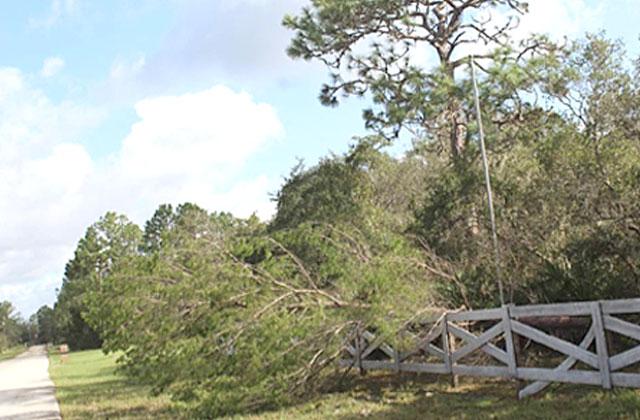By Sandi Switek
UF-IFAS Osceola Extension Services
As much as we would prefer not to think about it, the time to plan for a hurricane is now. Besides getting a supply of water, batteries, and food that won’t spoil, we need to think about preparing our landscape as well.
Probably the most important landscape concern would be our trees, which will be subjected to the full force of whatever winds we may have. While we can usually prepare small trees and plants ourselves, a certified arborist may be needed for the large ones. Since these professionals cannot just rush over to your place whenever a storm appears in the forecast, it is best to call for help now if needed.
In order to make things safer for you, a certified arborist can thin out tree canopies so that wind can blow through them. The arborist may also remove large branches hanging over your roof, as well as limbs which may be subject to failure. Don’t hire a company which does not have a certified arborist or a company which tops trees. Besides causing a tree to look unsightly, the practice of tree topping weakens the tree for the future.
If you have smaller trees, here are some guidelines for you to do yourself:
- Remove dead or broken branches;
- Stake new trees or leaning trees;
- Prune for a healthy central leader. (One main trunk, rather than two or more);
- Cut off dead fronds on palms;
- Get vines out of trees to improve wind resistance.
- As always, don’t subject tree roots to heavy weight, such as vehicles parking or driving over the root zones. Many tree roots are near the surface and are easily damaged.
- And, for the future, don’t plant trees too close to concrete or houses, where roots cannot spread out. Also, avoid planting under electrical wires.
Here are a few other outdoor tasks to think about:
- Clean your gutters to allow water to flow away;
- Think of a safe place to put potted plants, lawn furniture, and other outdoor items that can blow around;
- Anchor down lightweight outdoor structures.
- Which trees are more likely to need help getting through a storm? In that category, the top tree in our area is the laurel oak. In 2004, over 60% of all fallen plant material collected in Central Florida consisted of laurel oaks. However, a certified arborist can make them safer by pruning for wind to blow through. Another one with weak roots is the sand pine, which locally is the most common pine with short needles. Similar to the laurel ok, the Water Oak is another one.
If you have oak trees but don’t know what kind they are, now would be the time to identify them. A live oak will have a rounded shape at maturity, and grows more slowly than a laurel oak. If your tree has grown super-fast, and has a more upright form, you could have a laurel oak. Leaves are darker and shinier on the backside than live oak leaves.
Also ranking low on wind resistance are Australian Pine, Leyland Cypress, Norfolk Island pine, and Golden rain tree.
But what could cause one of the good trees to fail? For starters, a large tree planted in a small area can be a victim since it cannot develop wide roots in that location.
A large tree in a poorly drained area cannot develop roots that are deep enough to anchor it well.
Older trees may be nearing the end of their lifespan anyway.
Trees planted too near concrete or houses will not have roots on those sides.
Damaged trees, such as from weed eater wounds, are already weak.
Diseased trees or those infested with boring insects will be weak.
What if we were thinking of planting some new trees? It’s not a bad idea, since it is overall beneficial to have trees. We just need to use some judgment as to which ones to put in yards where they could reach a house. In fact, a group of the right trees can actually help, providing some protection for the house.
What are some of the right trees? Bald cypress, Crape Myrtle, Pond Cypress, Southern magnolia, Sabal palm, Sand live oak, live oak if well drained, date palms (Robellini, Canary Island), Bottlebrush, American holly, Dahoon holly, Yaupon holly, Tibouchina, red maple, Winged elm, American elm, Gumbo limbo.




